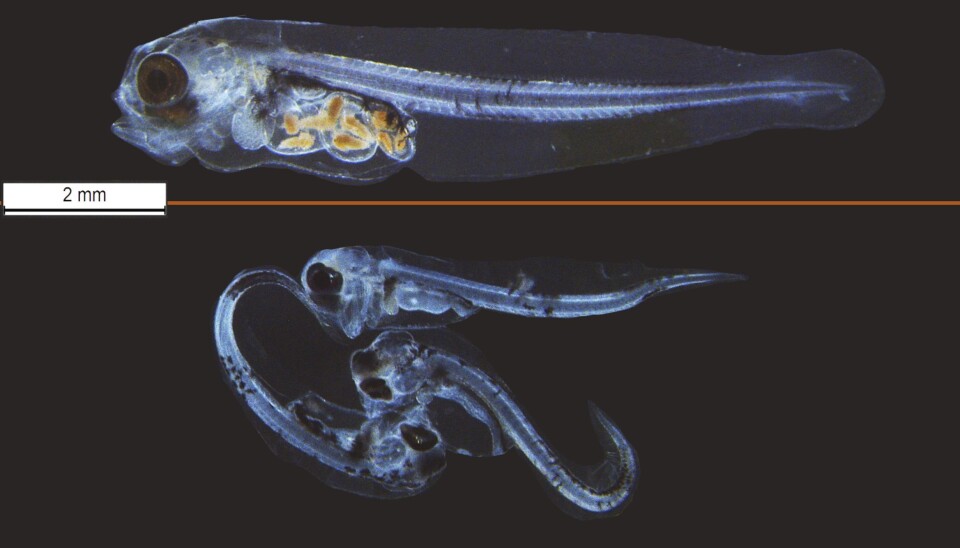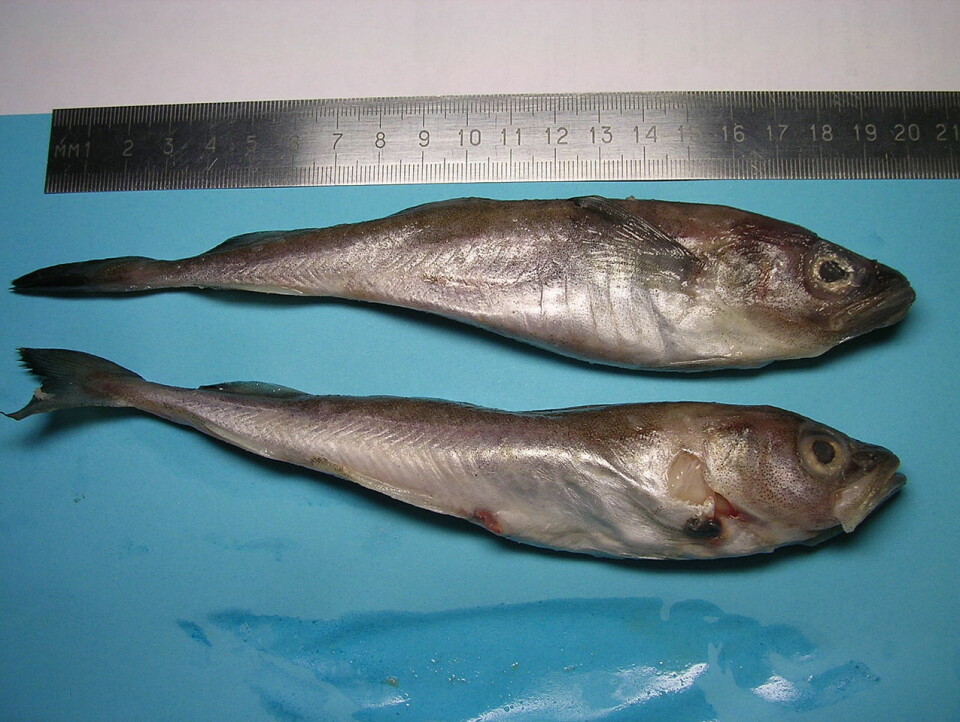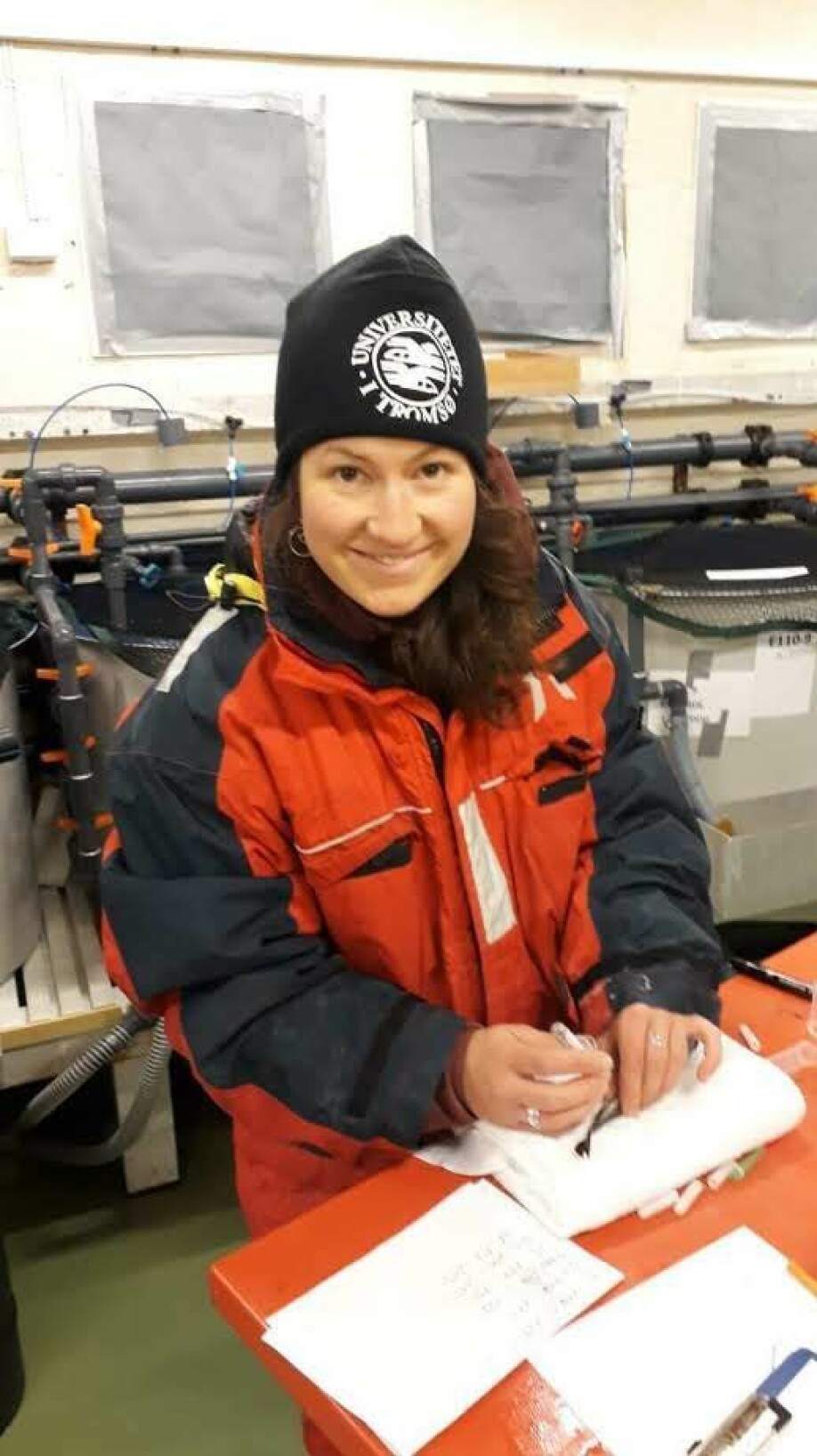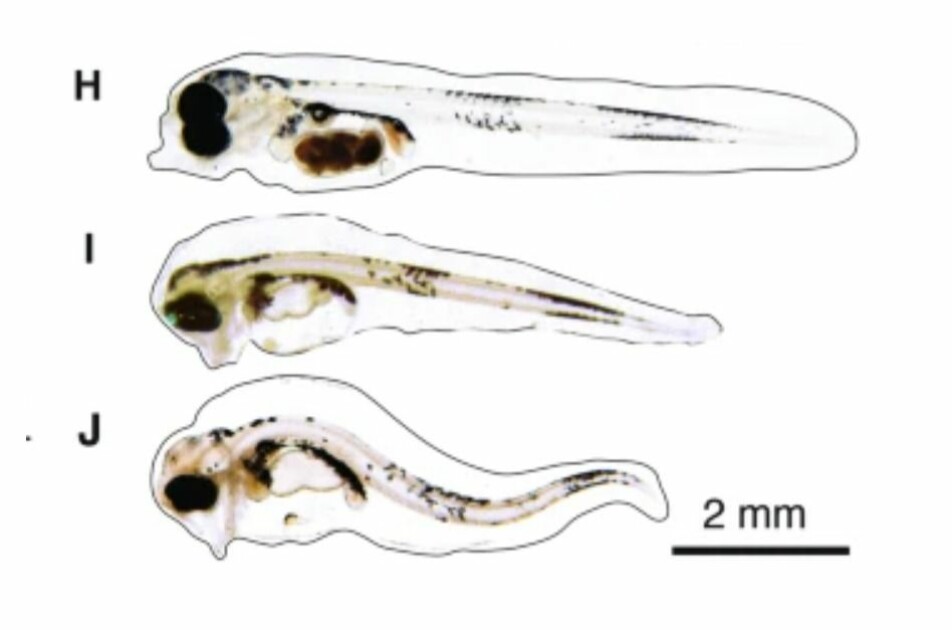
Fish in the Arctic deformed by tiny amounts of oil contamination
Polar cod are very sensitive to crude oil contamination, a new study shows.
Polar cod, also known as Arctic cod, like the ice-cold water in the Arctic. They have antifreeze proteins in their blood and lay eggs under the sea ice in winter.
Warmer temperatures and declining sea ice pose a problem for the fish, according to the Norwegian Institute of Marine Research (IMR). If the polar cod are struggling, it’s also bad news for many other species in the Arctic that eat the little fish.
“Quite a few animals that we think of in the Arctic, like seals, narwhals and seabirds, have a diet that’s almost 100 percent polar cod, at least for part of the year,” says Morgan Lizabeth Bender.

Bender is a researcher in the Department of Arctic and Marine Biology at UiT Norway's Arctic University.
Bender and her colleagues have been doing research which shows that small amounts of oil pollution can do great damage to polar cod fry, especially in combination with warmer water.
Hometown hit by oil disaster
Bender has been researching how oil pollution affects polar cod since 2013, including writing her doctoral dissertation on the topic.
Now she's in Alaska where she hails from.
“The area I come from in Alaska was hugely affected by an oil spill in 1989. It happened one year before I was born, in the fjord area where my family lives and works,” she said.
The environmental disaster was the Exxon Valdez accident, where an oil tanker ran aground, releasing 33 000 tonnes of crude oil into the vulnerable environment.
"That event could be why I’ve always been so curious about this topic and the impact on people in fairly untouched areas," says Bender.
It’s no coincidence that she and her colleagues chose the polar cod for their study of the possible consequences of oil spills in the Arctic.
“Polar cod is a somewhat difficult species that hasn’t been researched that much. The fish are difficult to find and to take care of in the lab. However, this species has a very important ecological role,” says Bender.

Like five drops in a swimming pool
The researchers participated in a cruise in the Barents Sea and caught adult polar fish, which were transported to a research station outside Tromsø.
In the winter, the fish laid eggs, and the experiment could begin.
Eggs were put into different containers. The aquariums had either an Arctic water temperature of 0.5 degrees or a higher temperature of 2.8 degrees. The higher temperature was selected to mimic an Arctic affected by climate change.
The aquariums contained either pure water or water contaminated to varying degrees by crude oil. The oil came from gravel that wasn’t in the aquarium itself, but which was part of the system, designed to simulate oil melting from sea ice.
The research work offered cold pleasure. The polar cod required both cold and dark so that the conditions were as close as possible to the comforts of their home.
“We relied on a lot of headlamps and down jackets and had very cold fingers when we were working in there,” Bender says.
In all cases, the level of crude oil in the water was very low. Bender says it’s difficult to give a sense of the amount. Crude oil contains hundreds of substances, and the researchers are using only some of them. But she's done a little figuring.
“The pollution level would be the equivalent of about five drops of oil in an Olympic size swimming pool,” she says.
Mixes with water
There doesn’t have to be a visible layer of oil on the water for it to have an impact.
“When you think of oil spills, you usually think of a layer that lies on top of the water that’s rainbow-like,” says Bender.
However, some components of crude oil are soluble in water.
“This type of contamination is perhaps the most relevant for Arctic situations. It’s really difficult to clean up after oil spills, and oil can get trapped in the ice. Then it can melt out at a completely different time from old oil or very diluted oil.
Bender explains that the study is not about subjecting polar cod to oil spill conditions. The experiment is aimed more at seeing how the fish react to diluted oil and residues left in the environment.
“The water-soluble fraction is the one we think will be most relevant for Arctic oil spills at very low levels,” says Bender.
Malformations and cardiac arrhythmia
The researchers tracked the evolution of the eggs from the time they were fertilized until the fry hatched and later began to feed. They took pictures along the way.
The eggs in the warm water hatched much faster than those in the cold water.
There was no significant difference between mortality in the aquariums at the egg stage.
But as the fish began to take shape, the researchers saw that something strange was happening to the fry that were exposed to oil.
“When they first hatched, there wasn’t much difference. But as their jaw, face and eyes started to develop, we saw very clearly that they weren’t forming properly,” says Bender.

The fry that were exposed both to warmer water and oil were most likely to develop abnormalities. The higher the oil concentration, the more common the fish malformations were.
For example, close to 100 percent of the fish had deformed jaws at the highest concentration of oil. The number of fry that were able to absorb nutrients decreased to zero.
The researchers also looked at the heart rate of newly hatched fry. The heart rate decreased in step with warmer water and higher oil concentration. Cardiac arrhythmias were also more prevalent among the oil-exposed fish in warm water.
Mortality was also higher among fry living in water contaminated with oil.
“The absolute highest mortality was among fry that experienced both a climate change situation and oil. We call this a synergistic effect. This means that the effect of temperature and oil was much greater when they co-occurred,” says Bender.
When the fry were large enough to start feeding, only eight percent survived in contaminated hot water and 23 percent in contaminated cold water.
Important for further research
Bender says the study cannot predict what will happen to the Arctic ecosystem in the event of a real oil spill.
“But we have seen that the polar cod is a very sensitive species that appears to be vulnerable to even super-low amounts of oil,” she says.

Sonnich Meier is researching marine toxicology at the Institute of Marine Research. Previously he researched the effect of oil spills on fish species, including polar cod. Meier has reviewed the new study.
He finds the study to be an interesting work and important for further research on the potential effects of oil spills in the Arctic.
The Institute of Marine Research has recently received funding to do research on this very topic, he says.
In the project, the researchers will model how an oil spill near the ice edge affects keystone species in the ecosystem, especially polar cod, according to the Institute of Marine Research.
Meier says that experimental data like that in the new study by Bender and colleagues are very important in order to be able to develop good models.
You might also like this Science Direct article on polar cod being more vulnerable to oil spills than expected.
Study confirms previous results
Meier further states that the results of the new study confirm previous experiments.
“The dose-effect relationship that causes serious effects place polar cod embryos among the most sensitive fish species studied.
He points to the EGGTOX project, where researchers at the IMR found that several types of fish fry suffered significant defects when they were exposed to oil in the egg stage of their development.
Polar cod have shown a downward trend since 2010, according to Environmental Monitoring of Svalbard and Jan Mayen - despite not being a harvested species. One of the reasons may be a rise in temperature.
“Polar cod is one of the fish species that is hardest hit by climate change in the Arctic,” says Meier and refers to a study that was published in the journal Marine Ecosystem Ecology last year.
“It’s important to study the effects of several stressors at the same time – like temperature and oil exposure – as was done in the new study. The study shows that increased water temperature can increase the harmful effects of oil exposure,” says Meier.
Translated by Ingrid Nuse.
Read the Norwegian version of this article on forskning.no.
Reference:
Morgan Lizabeth Bender: "Combined effects of crude oil exposure and warming on eggs and larvae of an arctic forage fish", Scientific Reports, April 16, 2021.































